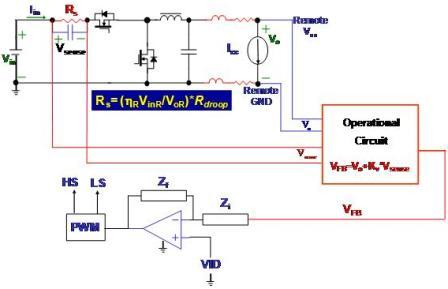RESEARCH
Input-Side Current Sensing Method (2003)

The basic idea of the proposed input-side current sensing method is to sense the average input current to achieve AVP. In the figure, Rs is used to generate the desired droop voltage but reduce the power loss dramatically since the input current is much lower than output current in VR application. For a 12V input, 1.3V output VRM with 100A output current, assuming that Rdroop is 1mohm, the additional loss is less than 1W.
The proposed method can not only reduce power loss caused by current sensing, but also keep high sensing accuracy. The detailed TOB analysis shows that the total TOB is about /-15mV, so it can meet Pentium4/Prescott TOB requirement of /-25mV.






















































































